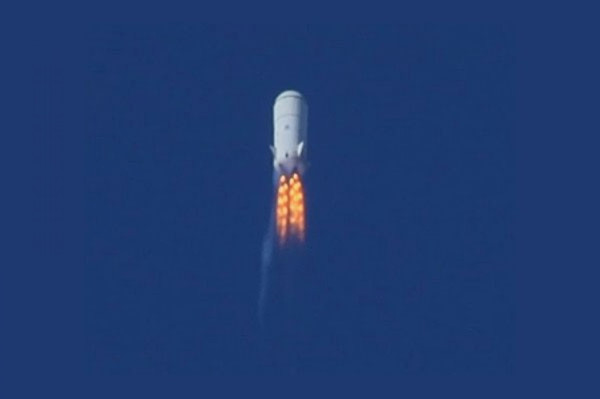'Step-by-Step, Ferociously,' Says Bezos, Undaunted by Blue Origin Space Ship Failure

Undaunted by the loss of a Blue Origin space ship making a test flight, Amazon founder Jeff Bezos has said the ambitious private space program goes ahead step-by-Step, ferociously.
Blue Origin, a private entrepreneurial space company, said on Friday a spacecraft misfired and crashed at an altitude of 45,000 feet in West Texas during a developmental test.
The billionaire said in a note on the official Blue Origin Web site that the setback was due to flight instability.
Three months ago, we successfully flew our second test vehicle in a short hop mission, and then last week we lost the vehicle during a developmental test at Mach 1.2 and an altitude of 45,000 feet. A flight instability drove an angle of attack that triggered our range safety system to terminate thrust on the vehicle, Bezos stated.
The accident, which industry officials said occurred on Aug. 24, was seen as a huge setback for the aspirations of Bezos about developing a dependable system for transporting tourists and astronauts into the space.
But Bezos said the company has already started work on their next development vehicle. Not the outcome any of us wanted, but we're signed up for this to be hard, and the Blue Origin team is doing an outstanding job. We're already working on our next development vehicle, Bezos said.
Bezos ended his statement with Gradatim Ferociter!, which is the Latin for Step-by-Step, Ferociously.
According to space.com, Blue Origin is focusing on suborbital spaceflight, and had been awarded a $22 million funding by NASA under its Commercial Crew Development (CCDev) program for development of concepts and technologies to support future human spaceflight operations. A year earlier Blue Origin had received another $3.7 million funding from NASA.
Apart from Blue Origin, other NASA CCDev partners include Boeing, Paragon, Sierra Nevada and United Launch Alliance.
Having retired its space shuttle fleet in July NASA plans to use U.S. spacecraft built by companies like Blue Origin to transport American astronauts to low-Earth orbit.
Blue Origin first used its Goddard vehicle and then migrated to the New Shepard spacecraft design at its facility in Culberson County, Texas, according to space.com. The Goddard vehicle had flown a on a short, successful test flight in November 2006. But Blue Origin sees New Shepard as supporting the commercial suborbital tourist market, the report says.
New Shepard system is a rocket-propelled vehicle designed to routinely fly multiple astronauts into suborbital space at competitive prices.
In addition to providing the public with opportunities to experience spaceflight, the New Shepard system will also provide frequent opportunities for researchers to fly experiments into space and a microgravity environment.
The New Shepard vehicle will consist of a pressurized Crew Capsule (CC) carrying experiments and astronauts atop a reliable Propulsion Module (PM).
Blue Origin is one of the three storied commercial space ventures backed by billionaire entrepreneurs. All three of them have become the most appreciated global figures of privately funded spacecraft. Blue Origin is one of them. The second one is Sir Richard Branson's space-travel company Virgin Galactic. And the third is PayPal co-founder Elon Musk's Space Exploration Technologies Corp.
© Copyright IBTimes 2025. All rights reserved.





















